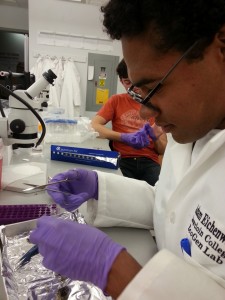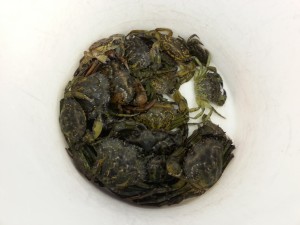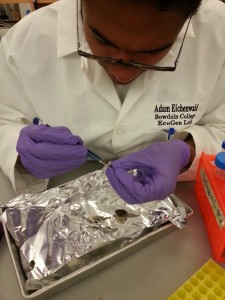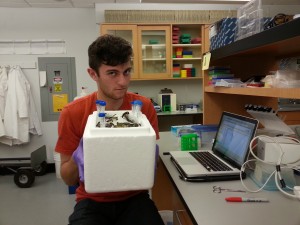What central questions did your summer research address?
 My research focused on determining what species invasive green crabs (Carcinus maenas) are eating and how frequently they are eating specific prey species. Specifically, I wanted to know if soft shell clams make up a large part of green crab diet. Green crabs are believed to be one of the major causes in the decline of the soft shell clam industry, and in past studies an inverse correlation has been observed between the abundance of green crabs and the abundance of soft shell clams. By understanding how often green crabs are eating soft shell clams, I would provide valuable insight into how green crab presence affects soft shell clam populations. As well as being a major predator to soft shell clams, green crabs are believed to be mowing down eel grass (Zostera marina) beds in the pursuit of prey species that live in these eel grass beds. I want to determine what green crabs are eating in eel grass beds, and possibly whether green crabs are eating eel grass.
My research focused on determining what species invasive green crabs (Carcinus maenas) are eating and how frequently they are eating specific prey species. Specifically, I wanted to know if soft shell clams make up a large part of green crab diet. Green crabs are believed to be one of the major causes in the decline of the soft shell clam industry, and in past studies an inverse correlation has been observed between the abundance of green crabs and the abundance of soft shell clams. By understanding how often green crabs are eating soft shell clams, I would provide valuable insight into how green crab presence affects soft shell clam populations. As well as being a major predator to soft shell clams, green crabs are believed to be mowing down eel grass (Zostera marina) beds in the pursuit of prey species that live in these eel grass beds. I want to determine what green crabs are eating in eel grass beds, and possibly whether green crabs are eating eel grass.
How specifically did you conduct this research?
 I answered these questions using next generation sequencing to sequence DNA extracted from green crab stomach contents. More specifically, I set out traps in two eel grass sites and two mud flats, fished the traps, removed the stomachs of the captured green crabs, and extracted the DNA from the stomach contents. I then used general primers to amplify DNA with PCR, and I sent out these amplified samples to be sequenced.
I answered these questions using next generation sequencing to sequence DNA extracted from green crab stomach contents. More specifically, I set out traps in two eel grass sites and two mud flats, fished the traps, removed the stomachs of the captured green crabs, and extracted the DNA from the stomach contents. I then used general primers to amplify DNA with PCR, and I sent out these amplified samples to be sequenced.
What did an average day of your work entail?
 An average day of work varied for me. Most days I was in the lab, either performing dissections on green crabs or doing bench work, but about twice a week I got the opportunity to go out to the Coastal Studies Center and do field work. This field work usually entailed going out on the skiff to check my green crab traps.
An average day of work varied for me. Most days I was in the lab, either performing dissections on green crabs or doing bench work, but about twice a week I got the opportunity to go out to the Coastal Studies Center and do field work. This field work usually entailed going out on the skiff to check my green crab traps.
What was one of the biggest challenges of your research?
One of the biggest challenges was trying to determine how many samples to run in a single lane for Next-generation sequencing. If we put too many samples in one lane, our reads turned out incomplete because the amount of DNA overpowered the sequencing capabilities, and if we used too few samples, we risked paying for the Next-Generation sequencing without using it to it’s full capabilities.
What was the most rewarding part of your research? What have you learned?
 The most rewarding part about my research was getting the opportunity to apply what I have learned as a biology major to an actual problem. The data that I received from this project will hopefully help future conservation projects.
The most rewarding part about my research was getting the opportunity to apply what I have learned as a biology major to an actual problem. The data that I received from this project will hopefully help future conservation projects.
Do you see yourself continuing to do research on this topic?
I would like to continue to learn about applied biology, and the invasive green crab is a particularly interesting case that I believe can be solved using applied biology.